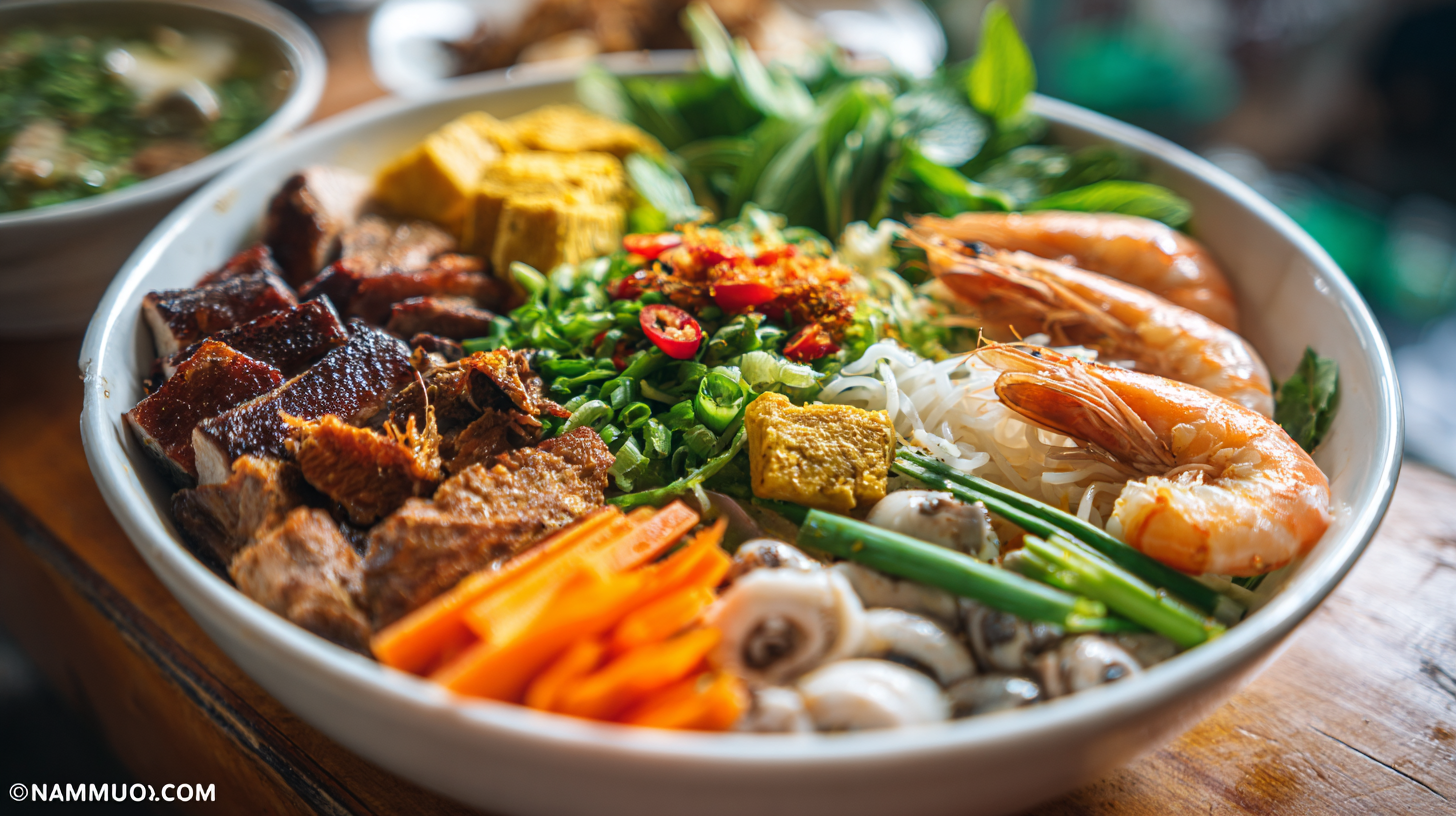When it comes to Vietnamese comfort food, mi thap cam is a true crowd-pleaser. This vibrant noodle dish translates to “mixed noodles” and lives up to its name with a delightful medley of ingredients. From tender meats and fresh seafood to crisp veggies and chewy noodles, every bite is a burst of flavor and texture.
What we love most about mi thap cam is its versatility. It’s a dish that brings together the best of land and sea, making it perfect for satisfying all kinds of cravings. Whether served in a flavorful broth or stir-fried to perfection, it’s a meal that feels both hearty and wholesome.
What Is Mi Thap Cam?
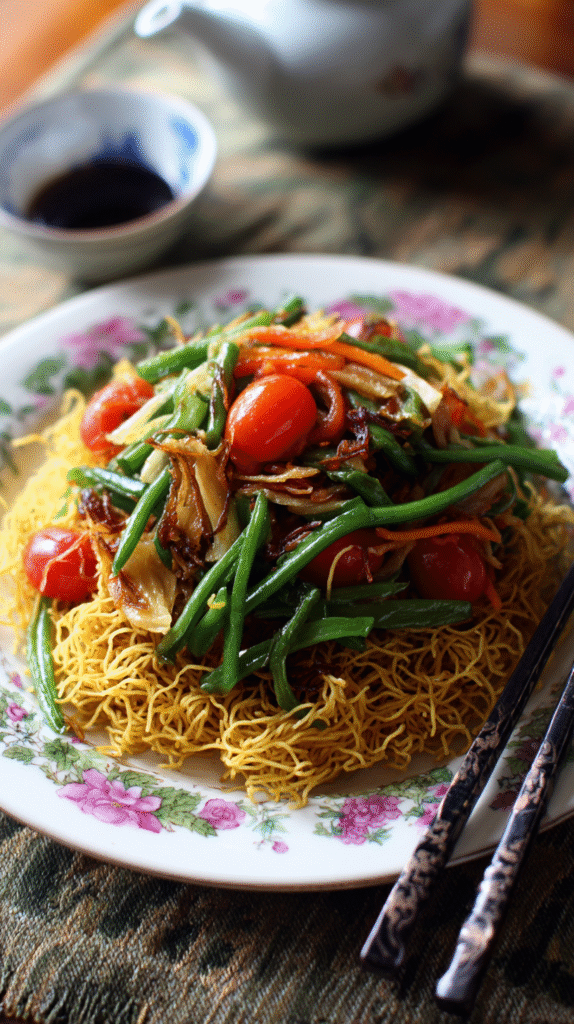
Mi thap cam, or “mixed noodles,” is a quintessential Vietnamese dish that showcases an artful blend of flavors and textures. It harmonizes a variety of components—springy egg noodles, succulent proteins, vibrant vegetables, and aromatic seasonings—all into one tantalizing bowl. This dish is celebrated for its adaptability, as we can enjoy it in two distinct styles: a warming noodle soup with savory broth or a deliciously stir-fried variation. Each version offers its own unique charm while staying true to the rich, bold flavors of Vietnamese cuisine.
What makes mi thap cam so remarkable is how it brings together diverse ingredients in such a balanced way. Tender slices of pork, juicy shrimp, or slices of chicken pair beautifully with the snap of fresh bok choy or bean sprouts. A flavorful, umami-packed sauce or broth ties everything together, making every bite a complete, satisfying experience. Whether we crave a comforting soup or a quick stir-fried meal, mi thap cam fulfills that craving with its irresistible combination of textures and tastes.
Ingredients

To make a delicious bowl of mi thap cam, we need fresh, flavorful ingredients. Here’s everything required, broken down into categories for easy preparation.
For The Broth
- 2 pounds pork bones, rinsed and cleaned
- 1 pound chicken (use thighs or drumsticks for the best flavor)
- 1 tablespoon vegetable oil
- 4 garlic cloves, smashed
- 2 shallots, thinly sliced
- 1 small onion, quartered
- 8 cups water
- 1 tablespoon fish sauce
- 1 teaspoon salt
- 1 teaspoon sugar
For The Noodles
- 1 pound fresh egg noodles
- 1 teaspoon vegetable oil (to prevent sticking after boiling)
For The Toppings
- 1/2 pound pork loin, thinly sliced
- 1/2 pound shrimp, peeled and deveined
- 1 cup bok choy, washed and chopped
- 1 cup bean sprouts, rinsed
- Fresh chili slices (optional, for heat)
Optional Garnishes
- 1/4 cup chopped green onions
- 1/4 cup chopped cilantro
- Fried shallots for added crunch
- Lime wedges for extra brightness
Tools And Equipment
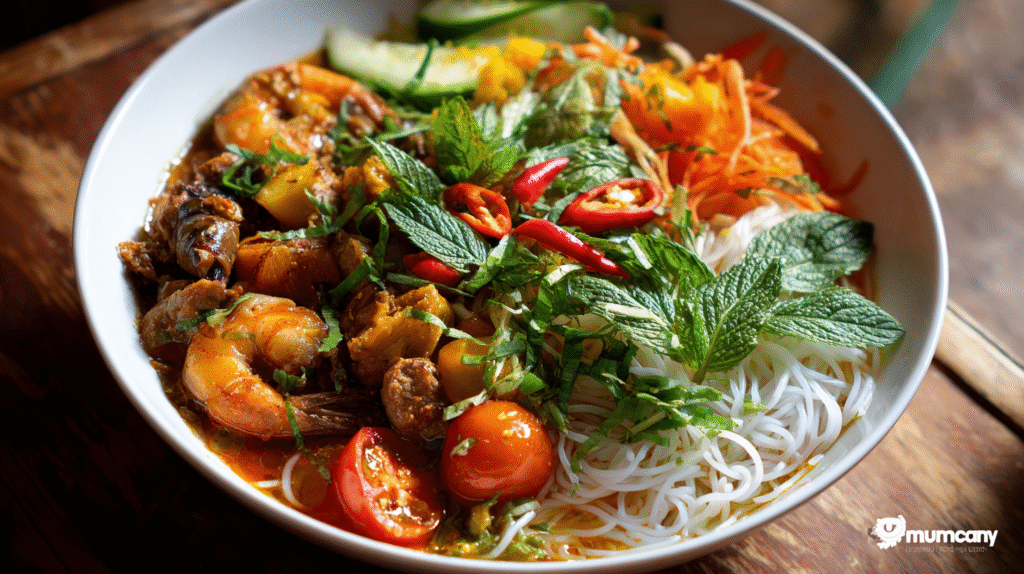
Preparing a flavorful bowl of mi thap cam requires the right tools and equipment to ensure a smooth cooking process. Here’s what we need to create this vibrant Vietnamese dish:
Essential Tools:
- Large stockpot: To simmer the rich, savory broth that forms the base of the dish.
- Mesh strainer: Perfect for skimming impurities from the broth and straining solids.
- Mixing bowls: For marinating proteins like shrimp or pork and organizing prepped ingredients.
- Cutting board and sharp knife: For finely chopping vegetables, slicing proteins, and preparing garnishes.
- Wok or large skillet: Ideal for stir-frying noodles or quickly cooking ingredients when preparing the dry version of mi thap cam.
- Tongs or chopsticks: Useful for handling noodles, blanching greens, and assembling the dish.
- Soup ladle: For serving broth neatly into bowls.
Optional Tools for Better Efficiency:
- Mandoline slicer: If you want uniformly sliced vegetables for an extra touch of presentation.
- Noodle strainer or spider skimmer: Makes transferring noodles or blanching ingredients in boiling water hassle-free.
- Garlic press: To efficiently mince fresh garlic for the aromatic broth.
Having these tools ensures we can manage each step—from creating the broth to assembling the final dish—with ease and precision. Proper equipment not only simplifies the cooking process but also helps us achieve restaurant-quality results at home.
Directions
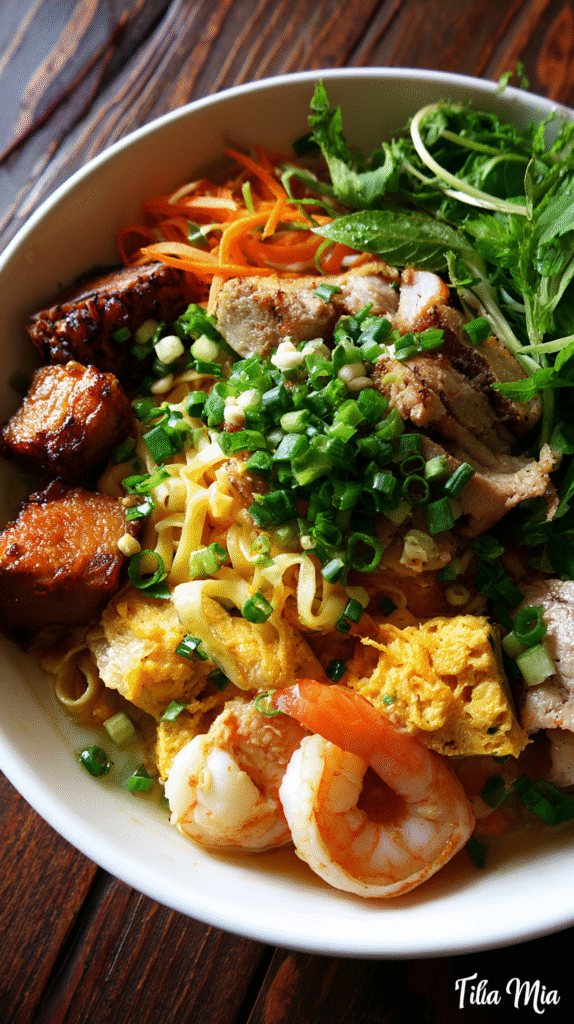
Let’s dive into crafting a delightful bowl of mi thap cam. Follow these step-by-step instructions to bring together the rich broth, springy noodles, and flavorful toppings for a hearty and satisfying meal.
Preparing The Broth
- Roast the bones: Start with 2 pounds of pork bones (neck or spine). Preheat your oven to 400°F. Place the bones on a baking sheet and roast for 20-25 minutes until golden brown to deepen their flavor.
- Clean the bones: In a large stockpot, add the roasted bones and enough water to cover them. Bring to a boil, then immediately discard the water. Rinse the bones under cold running water to remove any impurities. This ensures a clear broth.
- Simmer the broth: Return the cleaned bones to the pot. Add 2 quarts of water, 1 daikon (peeled and cut into chunks), 1 ounce of dried shrimp or cuttlefish, 1 tablespoon of salt, 2 tablespoons of fish sauce, and 1 teaspoon of sugar. Optionally, add a pinch of monosodium glutamate for enhanced umami. Bring the mixture to a boil, then reduce the heat to low. Simmer uncovered for 2-3 hours, skimming impurities periodically.
- Strain the broth: Once simmered, strain the broth through a fine mesh strainer to remove solids. Keep the broth warm until ready to assemble the dish.
Preparing The Noodles
- Boil the noodles: Bring a large pot of water to a rolling boil. Add 1 pound of fresh egg noodles and cook according to the package instructions, typically for 2-3 minutes. Stir gently to separate the strands.
- Rinse and coat: Drain the noodles and rinse under cold water to stop the cooking process. Toss with 1 tablespoon of vegetable oil to prevent sticking and set aside.
Preparing The Toppings
- Cook the proteins: In a skillet or wok, heat 1 tablespoon of vegetable oil over medium-high heat. Add 1 cup of thinly sliced pork loin and sauté until cooked through, about 3-4 minutes. Remove and set aside. In the same skillet, cook 1 cup of peeled and deveined shrimp until pink and opaque, about 2-3 minutes. Set aside.
- Blanch the vegetables: Bring a pot of water to a boil and blanch 2 cups of bok choy for 1 minute, then shock in ice water to retain their vibrant color. Similarly, briefly blanch 2 cups of bean sprouts and set aside.
- Prepare garnishes: Chop 2 green onions and 1/4 cup of cilantro, fry 2 tablespoons of shallots until crispy, and slice 1 lime into wedges. Cut optional chili slices if additional heat is desired.
Assembling The Mi Thap Cam
- Portion the noodles: Divide the cooked egg noodles evenly into serving bowls.
- Add toppings: Arrange the sautéed pork, shrimp, bok choy, and bean sprouts on top of the noodles.
- Ladle the broth: Pour the hot, flavorful broth over the noodles and toppings until the bowl is generously filled.
- Garnish: Finish with chopped green onions, cilantro, fried shallots, and a lime wedge for a pop of freshness. Add chili slices if you like a spicy kick.
- Serve and enjoy: Serve immediately with extra lime wedges and chili sauce on the side for customization.
Tips For The Perfect Mi Thap Cam
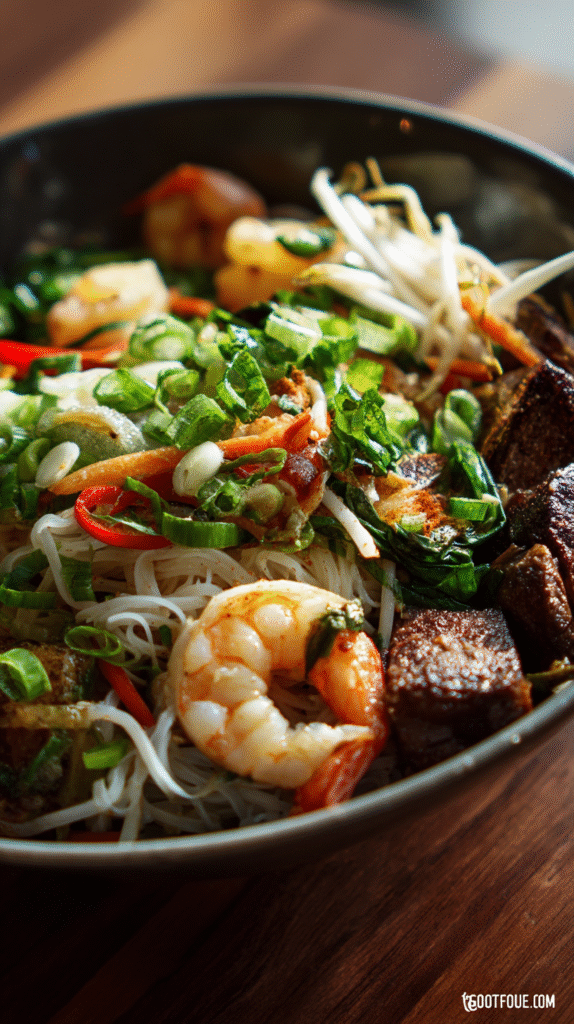
Creating the perfect bowl of mi thap cam requires attention to detail and a few insider techniques to bring out the best flavors and textures. These tips will help you elevate your dish to restaurant-quality right at home.
1. Prioritize a Clear and Flavorful Broth
The broth is the heart of mi thap cam. For a clear broth with robust flavor:
- Blanch pork bones in boiling water for 8 minutes. This step removes impurities that could cloud the broth.
- Rinse the bones thoroughly under cold water before simmering.
- Roast yellow onions, dried shrimp, and dried squid. Light charring enhances depth and complexity, adding a smoky note to the broth. Use a toaster oven or open flame for this step.
2. Select Quality Ingredients
Investing in fresh, high-quality ingredients ensures the best results:
- Opt for meaty pork neck bones. They contribute both flavor and richness to the broth.
- Source dried shrimp and dried squid for their essential, umami-packed flavors.
- Use fresh egg noodles for their springy, chewy texture. A quick toss in a touch of vegetable oil will keep them from clumping.
3. Perfect Your Noodle Texture
Bouncy and perfectly cooked noodles are key:
- Boil the fresh egg noodles for the recommended time on the package. Do not overcook them.
- Immediately rinse the noodles under cold water to halt the cooking process and keep them firm.
- Toss noodles lightly with oil to prevent sticking and maintain their chewiness.
4. Cook Proteins with Balance
To achieve tender and flavorful proteins:
- Marinate pork and shrimp with a light seasoning of salt, pepper, and fish sauce to enhance their natural taste.
- For shrimp, avoid overcooking by boiling just until they turn pink and opaque.
5. Blanch Vegetables Strategically
Veggies should stay vibrant and crisp:
- Blanch bok choy and bean sprouts for just a few seconds in boiling water.
- Shock them in an ice bath to preserve their bright color and crunch.
6. Assemble with Care
The final presentation matters:
- Layer noodles as the base, arrange the proteins, and place blanched vegetables around the bowl.
- Ladle hot, fragrant broth over the noodles and toppings. Aim for an even distribution to soak the flavors through.
- Finish with garnishes like chopped green onions, cilantro, fried shallots, and lime wedges for a flavorful and visually appealing touch. Don’t skip optional chili slices if you enjoy a bit of heat.
Make-Ahead And Storage Instructions
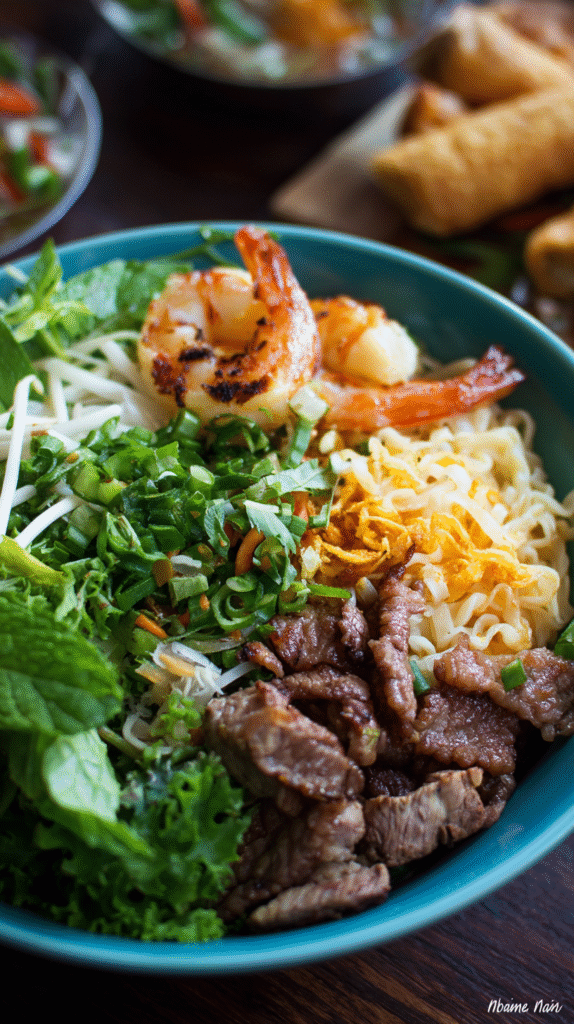
When it comes to mi thap cam, a little preparation can go a long way in saving time without compromising flavor. Here are our tips for making parts of the dish ahead and storing leftovers properly to keep everything fresh and delicious.
Make-Ahead Instructions
- Protein and Vegetables: We can cook the proteins, such as pork, shrimp, or chicken, and blanch the vegetables, like bok choy and bean sprouts, 2 to 3 days in advance. Store each component separately in airtight containers in the fridge to maintain their textures and flavors.
- Broth Preparation: The broth can be made ahead of time, up to 3 days in advance. After simmering and straining, let it cool completely. Store it in an airtight container in the refrigerator. Reheat gently when ready to serve.
- Noodles: Crispy noodles should be prepared just before serving to retain their delightful crunch. However, if you plan to stir-fry the noodles, you can cook and rinse them up to a day before. Toss them lightly in vegetable oil to prevent sticking, then store them in an airtight container in the fridge.
- Toppings and Garnishes: Chop cilantro, green onions, and any other garnishes a day in advance. Store them in an airtight container with a slightly damp paper towel to keep them fresh.
Storage Instructions
- Refrigeration: Leftover stir-fry mixtures, including proteins, vegetables, and sauce, can be stored together in an airtight container in the refrigerator for up to 5 days. For soup versions, keep the broth separate from noodles and toppings to prevent sogginess, and refrigerate them in sealed containers.
- Reheating: To reheat mi thap cam, warm the broth or stir-fry mixture over gentle heat on the stovetop. Avoid overcooking to preserve the textures of the proteins and vegetables. For noodles, quickly pan-fry or toss them in a hot wok with a splash of oil to revive their texture before serving.
By preparing components ahead of time and following proper storage practices, we can easily enjoy mi thap cam while maintaining its vibrant flavors and textures.
Serving Suggestions
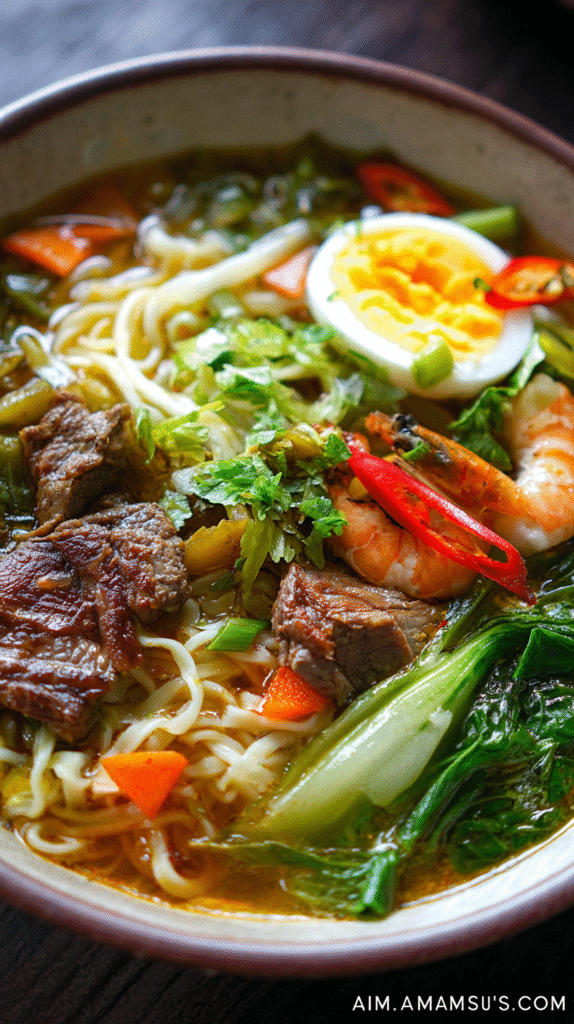
When it comes to serving mi thap cam, presentation and balance are key. Here’s how we assemble and serve this vibrant dish for a satisfying meal:
Assembly
Start by placing a portion of cooked egg noodles into a deep serving bowl. Arrange the toppings strategically for both aesthetics and flavor balance. Lay slices of tender pork butt on one side of the noodles. Next, add a few sautéed shrimp for a delightful burst of seafood sweetness. Include a couple of quail eggs, which add a smooth, creamy texture. Sprinkle fried pork fat (“tep mo”) sparingly over the bowl for a savory crunch.
It’s time to add the herbs. Fresh chrysanthemum leaves and garlic chives bring a burst of freshness and mild bitterness to complement the dish’s richer components. Trim these herbs into bite-sized pieces before scattering them on top. Combine thoughtfully for a perfect mix of colorful, aromatic toppings.
Broth
The broth ties everything together. Carefully ladle hot, fragrant broth over the noodles and toppings, ensuring it submerges the noodles while leaving the vibrant toppings at least partially visible for a mouthwatering presentation. The broth, simmered with pork bones, onions, and spices, delivers deep umami flavor that completes the dish.
Garnishes
For an extra layer of flavor and visual appeal, don’t forget the optional garnishes. Toss on some finely chopped green onions, fragrant cilantro leaves, and crispy fried shallots. For those who like a tart kick, serve with lime wedges on the side. Add chili slices or chili oil for a touch of heat if desired.
Serve the bowl immediately while the broth is still steaming hot. Encourage diners to mix the components gently to ensure a bite packed with all the flavors and textures that define mi thap cam.
Conclusion
Mi thap cam is more than just a meal; it’s a celebration of flavors, textures, and the vibrant spirit of Vietnamese cuisine. Whether we’re craving something warm and comforting or quick and satisfying, this dish has a way of bringing joy to our table.
With a bit of care and the right ingredients, we can easily recreate this culinary masterpiece at home. From its aromatic broth to its colorful toppings, mi thap cam invites us to savor every bite and share the experience with loved ones. Let’s embrace the art of cooking and enjoy this delightful dish together.
Frequently Asked Questions
What is mi thap cam?
Mi thap cam, or “mixed noodles,” is a popular Vietnamese dish featuring a combination of tender meats, fresh seafood, crisp vegetables, and chewy egg noodles. It can be served in a savory broth or stir-fried, offering a flavorful and versatile meal.
What are the main ingredients of mi thap cam?
The dish typically includes egg noodles, proteins like pork, chicken, or shrimp, vegetables like bok choy and bean sprouts, and a flavorful broth or sauce. Garnishes like fried shallots, cilantro, and lime enhance the presentation and taste.
How is the broth for mi thap cam made?
The broth is made by simmering pork bones, chicken, garlic, shallots, onion, fish sauce, salt, and sugar. It results in a rich, aromatic base that ties the dish together.
What tools are essential for making mi thap cam?
Key tools include a stockpot for broth, a mesh strainer for impurities, a wok or skillet for stir-frying, and cutting tools for veggies and proteins. Optional tools like a mandoline slicer or garlic press can improve efficiency.
Can mi thap cam be made ahead of time?
Yes! You can prepare the broth, proteins, and vegetables 2–3 days ahead and store them in airtight containers. However, noodles should be cooked fresh for the best texture.
How do I store leftover mi thap cam?
Store leftovers in separate airtight containers in the refrigerator for up to 5 days. Reheat the broth and proteins separately, and cook fresh noodles for optimal taste and texture when serving.
Are there any tips for creating restaurant-quality mi thap cam?
Focus on a clear, flavorful broth, use fresh, high-quality ingredients, and blanch vegetables for vibrant color and crispness. Layer ingredients carefully for an appealing presentation.
Can I customize mi thap cam with different ingredients?
Absolutely! Mi thap cam is versatile. You can substitute proteins, such as using tofu for a vegetarian version, or add more vegetables to suit your preference.
What garnishes work best with mi thap cam?
Garnishes like fried shallots, green onions, cilantro, lime wedges, and sliced chili enhance both flavor and presentation, adding brightness and heat to the dish.
How should mi thap cam be assembled?
Start with cooked egg noodles, layer on proteins like pork or shrimp, add sautéed or blanched vegetables, and ladle hot broth or sauce over the top. Finish with garnishes for a complete dish.
